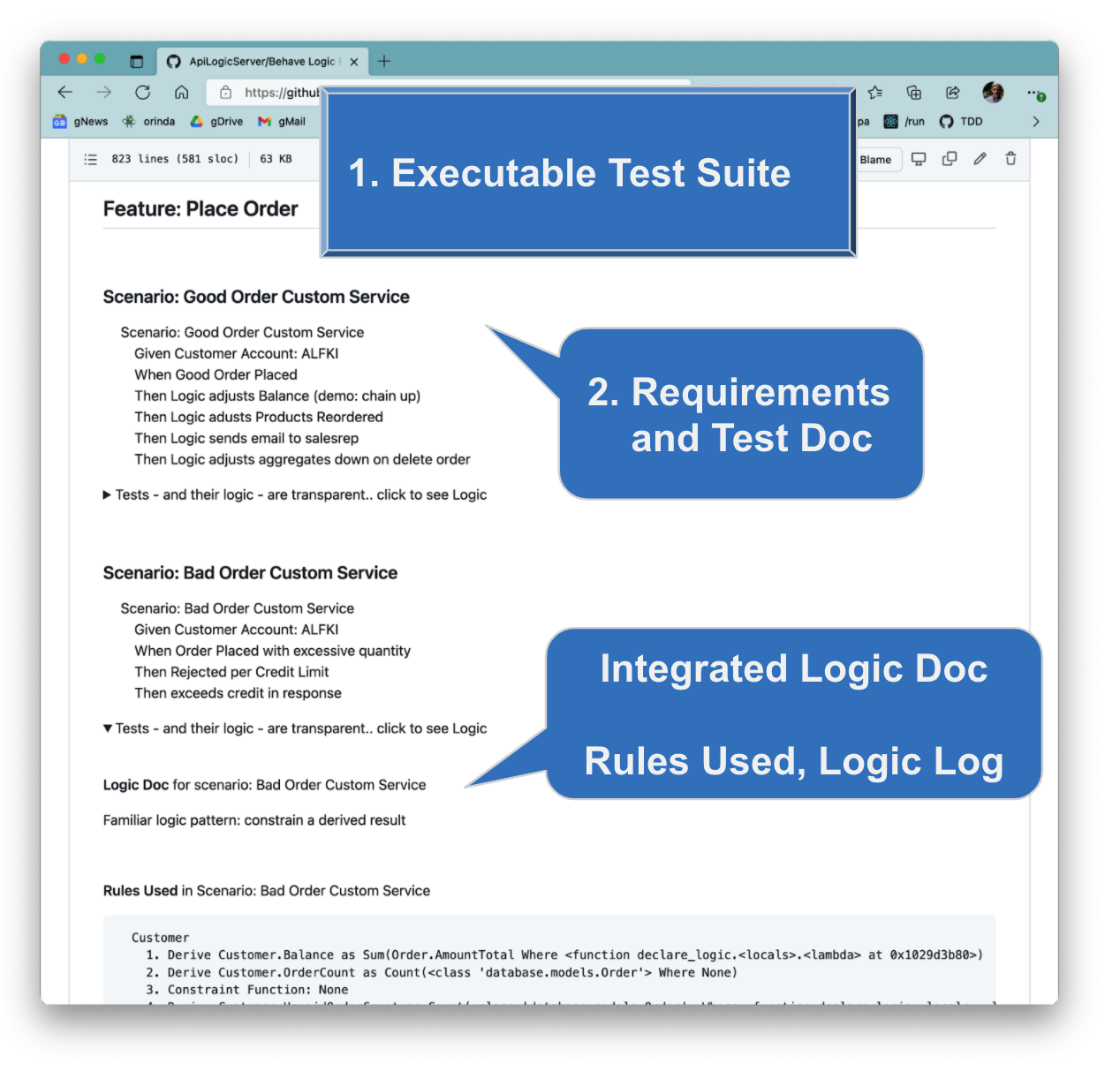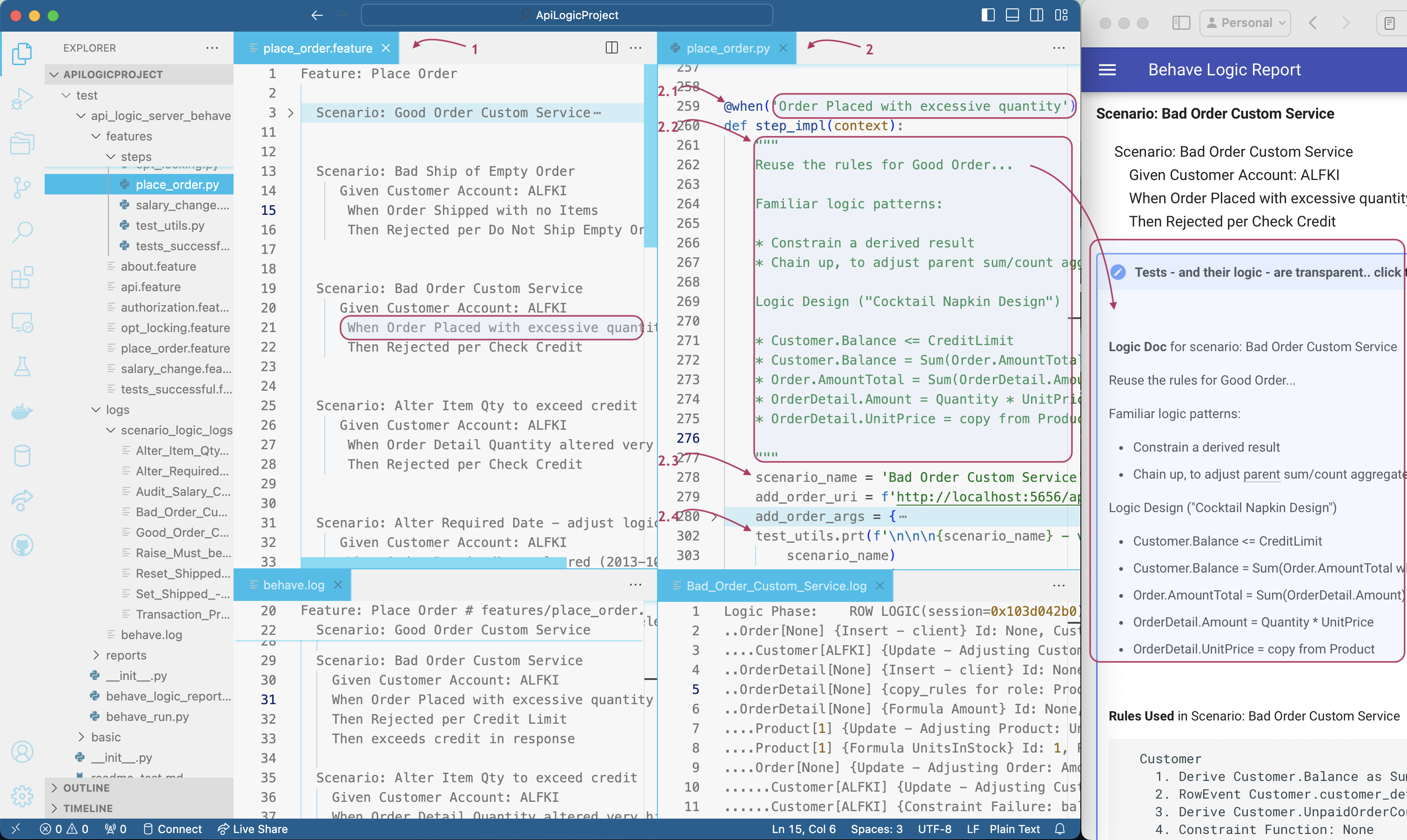Agility With Behave

You can optionally use the Behave test framework to (here is an Agile Approach for using Behave):
-
Capture Requirements, as Tests: use the Behave in your IDE to capture requirements. Behave is based on Behavior Driven Design, so your requirements are phrased as tests.
-
Run Automated Test Suite: create Python code to execute tests. You can then execute your test suite with 1 command.
-
Requirements and Test Documentation: as shown below, you can then create a wiki report that documents your requirements, and the tests (Scenarios) that confirm their proper operation.
- Integrated Logic Documentation: the report integrates your logic, including a logic report showing your logic (rules and Python), and a Logic Log that shows exactly how the rules executed. Logic Doc is transparent to business users, so can further contribute to Agile Collaboration.
Testing
Experienced professionals advocate test suites, for answering key questions like:
| Key Question | Best Practice |
|---|---|
| What is the formal definition of the systems' functionality? | The test suite defines the functionality |
| Is the system ready to go-live | The test suite passes |
| Did my maintenance change break something? | Run the test suite |
Popular Frameworks
API Logic does not dictate any particular framework. You can use (and we do internally) popular frameworks such as PyUnit (bundled with Python) and unitest.
The Behave Framework
One such framework is behave. Since it can produce documentation, we have built in support as described here.

Behave is a framework for defining and executing tests. It is based on TDD (Test Driven Development), an Agile approach for defining system requirements as executable tests.
Using Behave

Behave is pre-installed with API Logic Server. Use it as shown above:
-
Create
.featurefiles to define Scenarios (aka tests) for Features (aka Stories) -
Code
.pyfiles to implement Scenario tests -
Run Test Suite: Launch Configuration
Behave Run. This runs all your Scenarios, and produces a summary report of your Features and the test results. -
Report: Launch Configuration
Behave Reportto create the wiki file shown here.
These steps are further defined, below. Explore the samples in the sample project.
1. Create .feature file to define Scenario
Feature (aka Story) files are designed to promote IT / business user collaboration.
2. Code .py file to implement test
Implement your tests in Python. Here, the tests are largely 1. read existing data, 2. run transaction, and 3. test results, using the API. You can obtain the URLs for reading/updatind data from the swagger.
Key points (see items 2.1, 2.2 etc in the diagram above):
-
Link your scenario / implementations with
@whenannotations, as shown for Order Placed with excessive quantity. -
Optionally, include a Python docstring on your
@whenimplementation as shown above, delimited by"""strings (see "Familiar logic pattern" in the screen shot, above). If provided, this will be written into the wiki report. -
Important: the system assumes the line following the docstring identifies the
scenario_name; be sure to include it. -
Include the
test_utils.prt()call; be sure to use specify the scenario name as the 2nd argument. This is what drives the name of the Logic Log file, discussed below.
3. Run Test Suite: Launch Configuration Behave Run
You can now execute your Test Suite. Run the Behave Run Launch Configuration, and Behave will run all of the tests, producing the outputs (behave.log and <scenario.logs> shown above.
-
Windows users may need to run
Windows Behave Run -
You can run just 1 scenario using
Behave Scenario -
You can set breakpoints in your tests
The server must be running for these tests. Use the Launch Configuration ApiLogicServer, or python api_logic_server_run.py. The latter does not run the debugger, which you may find more convenient since changes to your test code won't restart the server.
4. Report: Launch Configuration `Behave Report'
Run this to create the wiki reports from the logs in step 3.
5. Testing considerations
Please see here for important considerations on optimistic locking and testing.